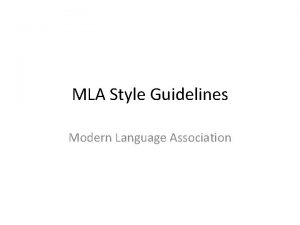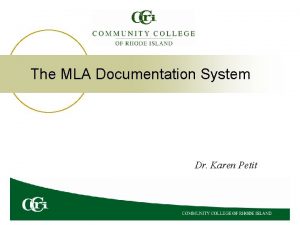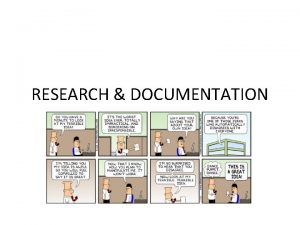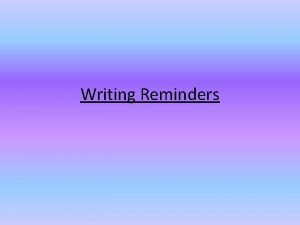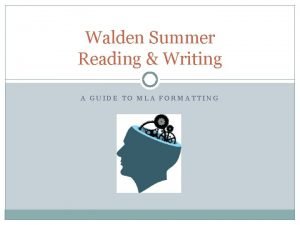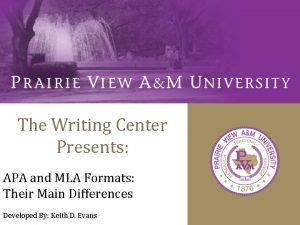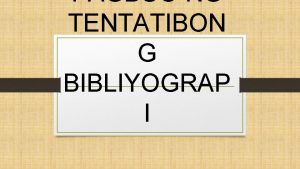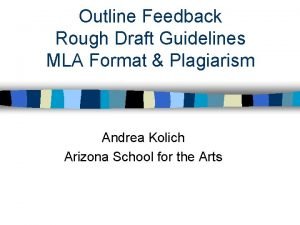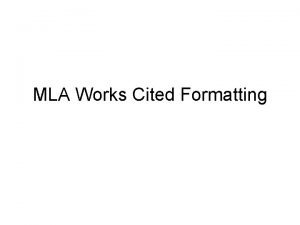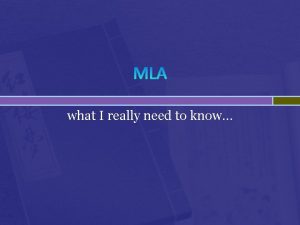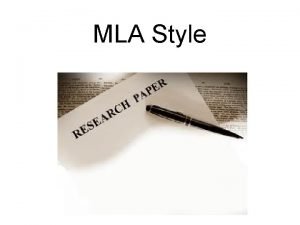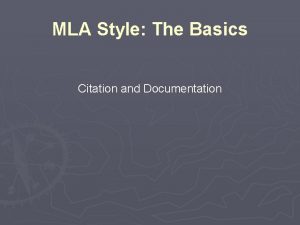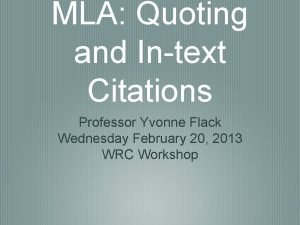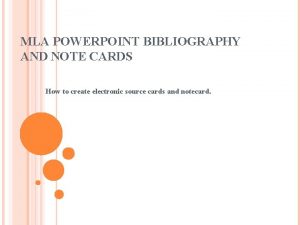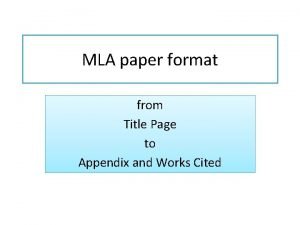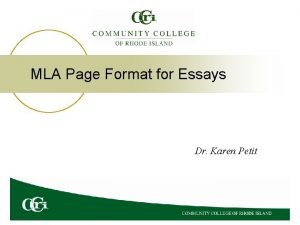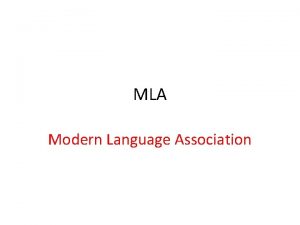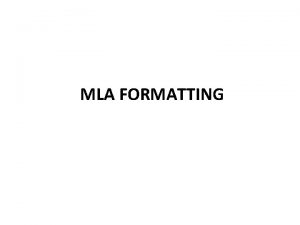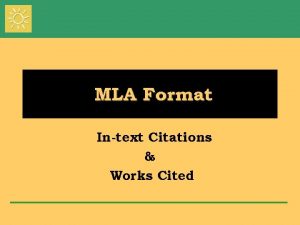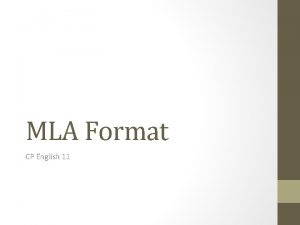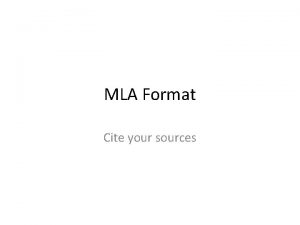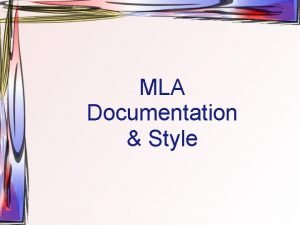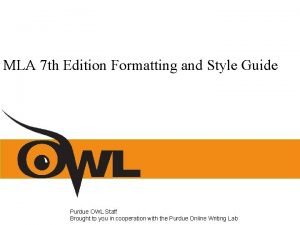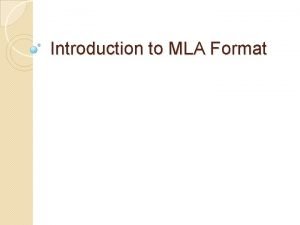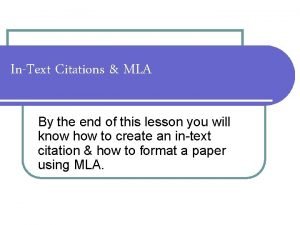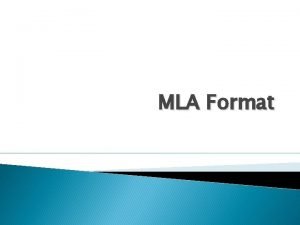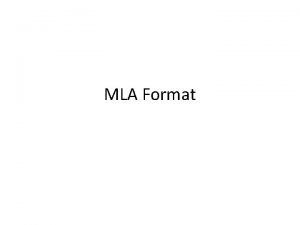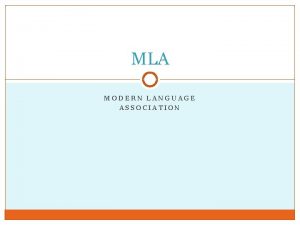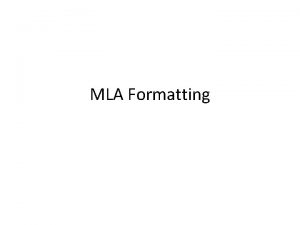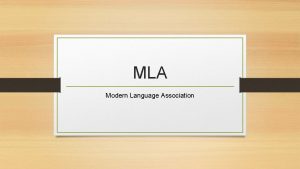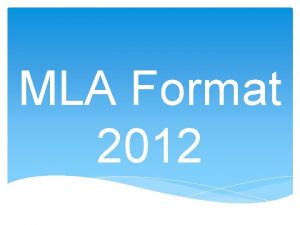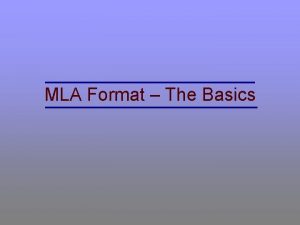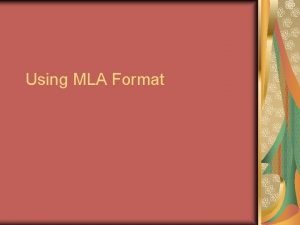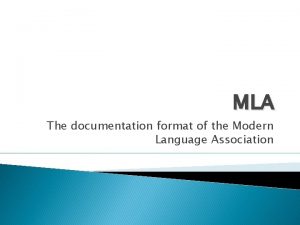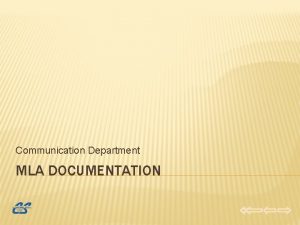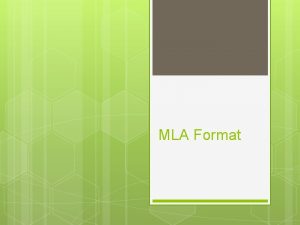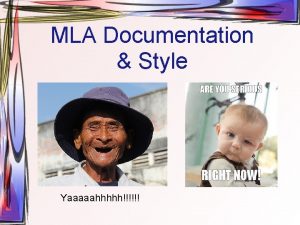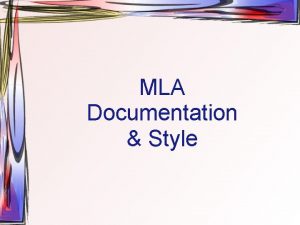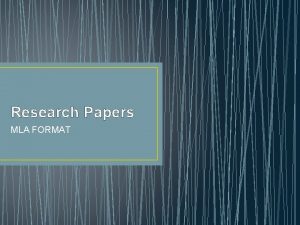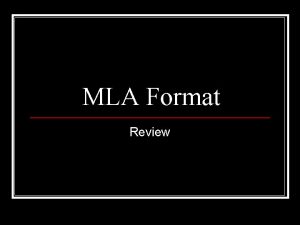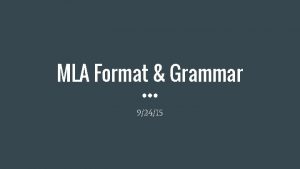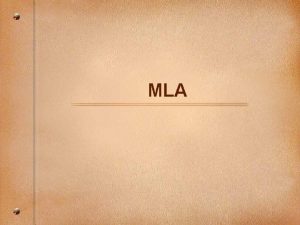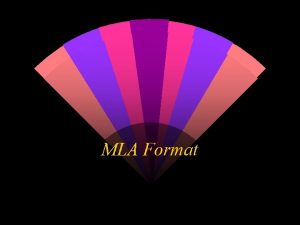MLA The documentation format of the Modern Language






























- Slides: 30

MLA The documentation format of the Modern Language Association

The Three Components of MLA � This documentation style has three basic components: ◦ Layout ◦ In-text citation ◦ Works Cited

Layout � The first page should have the following in the top left corner in precisely this order: � Your name � Name(s) of your instructor(s) � Class (for us, it’s English B 1 A) � Due date of your paper written in the following format: Day (as a number) Month (as a word) Year (as a number) � Next, the title should be on the next line and centered. � Next, double space the whole paper (format, paragraph, double space, ok)

Layout: Example Heading John Doe Ms. Lynde English B 1 A 17 July 2012 My Ever so Clever Essay Title

Layout � You will need to put your last name and the page number in the upper right hand corner of each page of your essay including your works cited page. This is most easily done with a header. However, if using a header, do not put the heading in the header since we only want the header to appear on the first page of the essay.

In-text Documentation � This part of MLA deals with how you use sources in your essay. � There are two main ways to correctly introduce sources into your paper: ◦ Direct quotations ◦ Paraphrase

Using Quotations � Quotations are the author’s words exactly. Therefore, if you use a direct quotation, you must make sure that you copy the words of the author exactly as they appear in the source and put quotation marks around them. You must also introduce them with a signal phrase and use appropriate parenthetical references.

More on In-text Citations �If you use the author’s name in the signal phrase, then cite only the page number in parentheses. ◦ Paul Thompson says, “The biggest surprise in recent teen-brain research is the finding that a massive loss of brain tissue occurs in the teen years” (5). � Signal Phrase=Blue � Parenthetical Reference= Red

More on Using Quotations � If you do not use the author’s name in the signal phrase, then use the name and page number in parentheses. ◦ Research shows that “a massive loss of brain tissue occurs in the teen years” (Thompson 5). � You should always introduce the author fully the first time, then refer to him or her only by last name after that. � Signal Phrase=Blue. Author name=Green

More on using Quotations � If the source doesn’t have an author’s name, substitute it with the title. �Research shows that “a massive loss of brain tissue occurs in the teen years” (“Brain Tissue and its Loss” 5). � Signal Phrase=Blue � Source Title=Green � Note that the source title must be punctuated correctly. Short works like articles are put in quotation marks. Long works like books or entire journal or periodical titles are italicized.

More on Quotations � If the source doesn’t have a page number, simply omit it. � Research shows that “a massive loss of brain tissue occurs in the teen years” (“Brain Tissue and its Loss”). � Signal Phrase=Blue � Source Title=Green

Paraphrase When you paraphrase, you must put the author’s ideas in your own words. � Paraphrases are usually about the same length as the original source. � Do not include your own opinion in the actual paraphrase. Remember, you are incorporating the author’s words to support your opinion. � � Paraphrases are cited and introduced just like quotes. ◦ According to Bell Hooks, loving parents are essential to our culture, but they must reconsider aligning discipline with punishment (30). ◦ Loving parents are essential to our culture, but they must reconsider aligning discipline with punishment (Hooks 3).

Works Cited � The Works Cited page comes at the end of your document and lists the works (sources) that you’ve actually cited (used) in your paper. � Under the eighth edition of MLA, works cited pages are governed by rules that are applied to each source, which we shall examine in the next slide. � However, there are some other things to be aware of: ◦ A works cited page is reverse indented. This means the first line of the source information sticks out and all subsequent lines are indented. The first line in the next source then sticks out and the pattern repeats. ◦ A Works Cited page, like the rest of the document, is double spaced. ◦ A Works Cited page is alphabetized by the last name of each author (or by the first large word of a title if no author is given).

MLA Works Cited Rules First, note that since MLA alphabetizes by author last name, when a single author is listed, the first and last names are reversed. For example, here is what it would look like with an actual author: Orwell, George

MLA Works Cited Rules � Next, note that when two authors are given, the names of the first author are reversed, but not the names of the second author. An example would look like this: � Smith, Ron and Edward Williams

MLA Works Cited Rules � If there are more than two authors, the current version has writer list the first author followed by the abbreviation et al. � An example would look like this: � Gorman, Tom et al.

MLA Works Cited Rules � Titles, unless intentionally written in a way that contradicts this by the original author, are capitalized according to the following rules: The first word and last word of the title are capitalized as well as every large word. � For example a title might look like this: � The Great Revolution of the Mind

MLA Works Cited Rules � Also, titles if they are only part of a longer work, the title is put in quotation marks. For example, a newspaper article is a part of an entire issue of a newspaper. � An example would look like this: � “The Great Debate”

MLA Works Cited Rules � If the title is not just a part of a longer work, the title is italicized. For example, the title of a book would be italicized or the title of a newspaper. � An example would look like this: � The New York Times

MLA Works Cited Rules Beyond these basics, eighth edition MLA has works cited entries list the following information in the following order with the following punctuation following it. Not that if a source is missing this information that MLA has the writer leave it out and go on to the next item in the list. � Author (followed by a period) � Title of source (followed by a period) � Title of “Container” (followed by a comma) � Other contributors (followed by a comma) � Version (followed by a comma) � Number (followed by a comma) � Publisher (followed by a comma) � Publication date (followed by a comma) � “Location” (followed by a period) �

MLA Works Cited Rules � Author is pretty self-explanatory and follows the rules previously mentioned.

MLA Works Cited Rules � Title of source is the name of a book in the case of a book or the name of the article in the case of an article. However, title of source does not include the name of the publication an article came from.

MLA Works Cited Rules � Title of container, means a metaphorical container that contains the source. For example, if the source is an article from the newspaper, the name of the newspaper itself would count as the “container” and if an article is from a website, the title of the website would be the “container. ”

MLA Works Cited Rules � Contributors means that sometimes a source has a number of additional contributors that help put the source together such as an editor or translator. This is not, however, where additional authors are listed. Note that these contributors would be labeled. For example, an editor would have the word editor listed in front of the name.

MLA Works Cited Rules � Version simply means what it says. For example the volume number of an academic journal would count as a version. If an edition is prominently listed on a book, it may be included as a version as well. � Note that if it is a volume number it, would be listed with the word “vol. ” in front of it

MLA Works Cited Rules � Number: � Some sources, such as academic journals, list an issue number as well. If this is the case, that number is listed with the abbreviation No. coming before it.

MLA Works Cited Rules � If the source has a publisher or publishing company listed (all books have a publisher for example), the publisher is listed.

MLA Works Cited Rules � The publication date is listed here. Follow the format given for the date in the heading of your paper. Also, if part of the date is left out (for example the day the source was published), simply leave it out and include the rest.

MLA Works Cited Rules � Location: � This is meant to call a reader’s attention a specific page range in a source or the url for a web page. If the location is a page range, use the abbreviation pp. in front of it. If it is a url, do not include the Http: //

Example � Here is an example of a source put in works cited format for the current edition of MLA: � Orwell, � Note George. 1984. Signet Classics, 1977. that when you have finished giving all of your information, the final piece of punctuation is always a period rather than a comma.
 Language font style
Language font style Karen petit
Karen petit Documentation in research
Documentation in research Top left corner mla format
Top left corner mla format Introduction on research proposal
Introduction on research proposal Mla format high school
Mla format high school Mla format specifications
Mla format specifications Reference page apa
Reference page apa Alin ang pinaka makapal na uri ng letra
Alin ang pinaka makapal na uri ng letra Mla format rough draft
Mla format rough draft Mla work cited
Mla work cited Mla format heading
Mla format heading Binti mla citation
Binti mla citation Mla cover page format
Mla cover page format Mla citation poem
Mla citation poem Mla format note cards
Mla format note cards Research paper appendix example
Research paper appendix example Mla format top left corner
Mla format top left corner Mla prefers times new roman font
Mla prefers times new roman font Paragraphs in mla format
Paragraphs in mla format Works cited page spacing
Works cited page spacing Citing a website with no author mla
Citing a website with no author mla Mla work cited page example
Mla work cited page example English citation format
English citation format What is mla format for citing sources
What is mla format for citing sources Mla page number format
Mla page number format Works cited page example
Works cited page example Sincerely in email
Sincerely in email Modified-block style
Modified-block style What is mla
What is mla Mla format heading
Mla format heading
